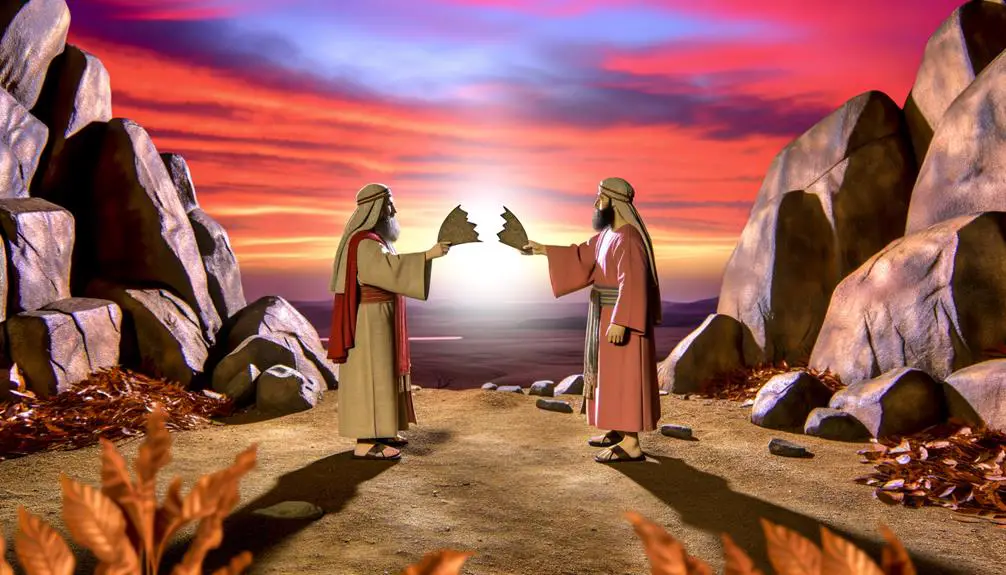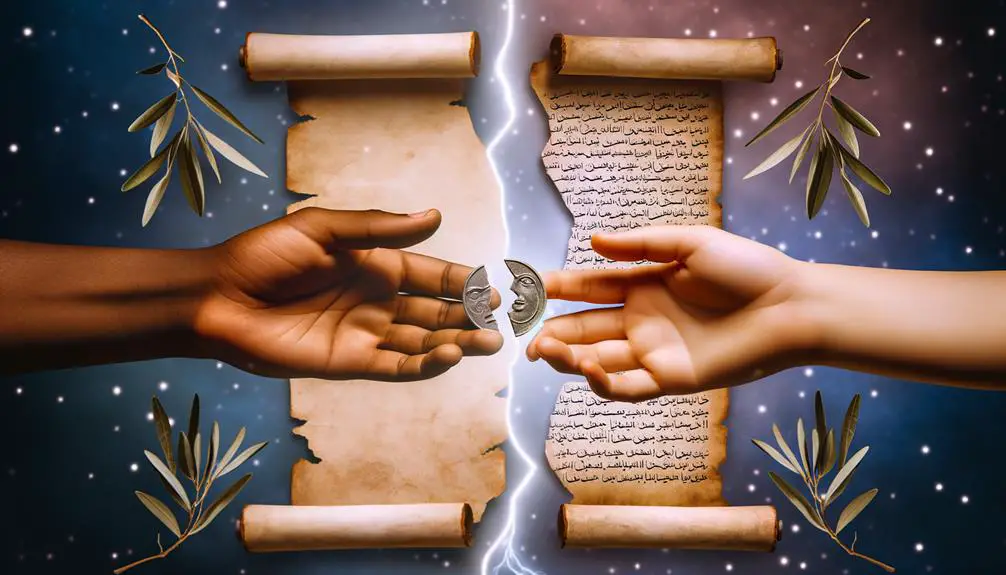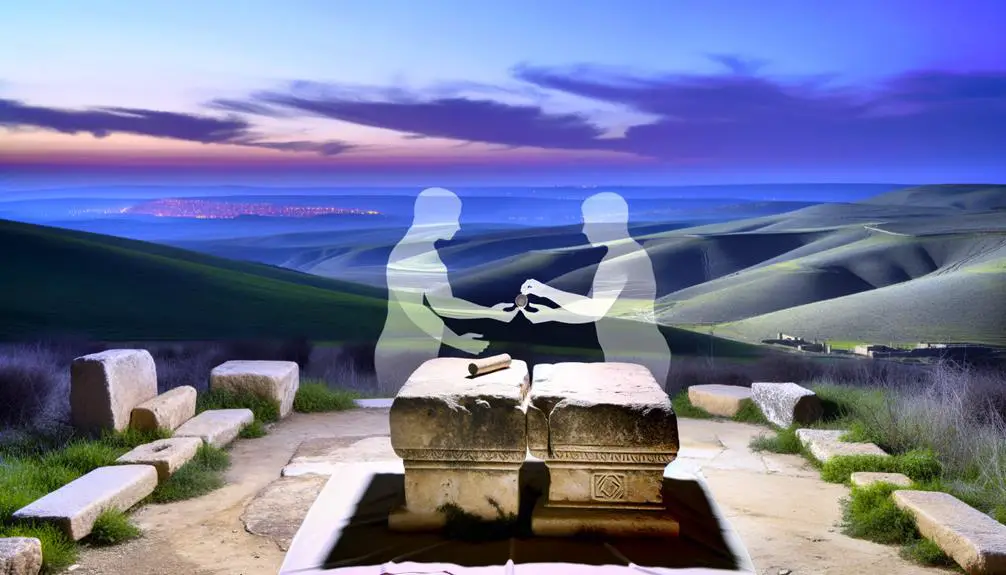Learn how Mizpah's biblical roots weave through tales of separation and unity, inviting a deeper exploration of its timeless significance.

Meaning of Mizpah in the Bible
Mentioning Mizpah might make many muse over its multifaceted meanings within biblical contexts. You've likely encountered it as a term that transcends simple geographical significance, evolving into a symbol of separation and connection.
Rooted in the ancient narratives of Genesis, Mizpah holds a historical and spiritual significance that stretches beyond its initial introduction. As you explore the layers of its interpretation, from a covenant marker to a modern symbol of longing and unity, you'll uncover how this term continues to resonate deeply within both personal and collective memories.
This journey into understanding Mizpah invites you to unravel its enduring relevance across centuries.
Key Takeaways
- Mizpah symbolizes a profound covenant made under divine watch, signifying protection and hope for reunion.
- It served as a strategic location for communal gatherings, fostering bonds and shared values.
- The town was central to ancient rituals, emphasizing emotional resilience and divine witness.
- Mizpah represents hope, strength, and collective cohesion, encouraging perseverance in challenging times.
Origins of Mizpah

Delving into the origins of Mizpah, we find its roots deeply embedded in the ancient biblical landscape, serving as a significant term that encapsulates both a geographical location and a profound spiritual symbolism. The linguistic roots of Mizpah, stemming from the Hebrew language, translate to 'watchtower' or 'lookout,' indicating a place of vigilant observation. This etymological insight provides a foundational understanding of Mizpah's dual role in ancient contexts as both a physical high ground for strategic defense and a metaphorical high ground for spiritual vigilance and connection.
As you explore the multifaceted nature of Mizpah, it's essential to recognize how its original meaning has transcended its biblical origins, influencing various cultural expressions, most notably in Mizpah jewelry. This type of jewelry, often inscribed with the phrase 'The Lord watch between me and thee, when we're absent one from another,' embodies the enduring sentiment of protection, separation, and remembrance. This adaptation of Mizpah's significance attests to its profound impact on human connections across time and space, moving beyond its initial context to symbolize a deep bond between individuals separated by distance.
The transformation of Mizpah from a geographical and spiritual term into a cultural symbol through Mizpah jewelry illustrates the dynamic interplay between language, spirituality, and human relationships. By tracing the linguistic roots of Mizpah, you gain a deeper appreciation for its historical depth and contemporary relevance, highlighting its role as a bridge between the ethereal and the tangible, the ancient and the modern.
Mizpah in Genesis

As you explore Mizpah in Genesis, you'll uncover the complex covenant between Jacob and Laban, marking a pivotal moment in biblical narratives.
This account not only reveals Mizpah's symbolic significance as a boundary and witness but also underscores its crucial location and role in ancient Near Eastern diplomacy.
Through a detailed examination, you'll appreciate how these elements intertwine, offering deep insights into the socio-religious fabric of the time.
Jacob and Laban's Covenant
Exploring the story of Jacob and Laban in Genesis reveals the profound significance of the Mizpah covenant, a pivotal moment that exemplifies the complex dynamics of trust, betrayal, and divine oversight within their relationship. This covenant emerges amidst a backdrop of Laban's deceit and Jacob's journey, each seeking blessings and prosperity, yet entangled in a web of manipulation and familial ties.
- Laban's Deceit: Tricking Jacob into marrying Leah before Rachel.
- Jacob's Journey: His quest for family and fortune, leading to the encounter with Laban.
- Divine Oversight: God's guidance and protection over Jacob.
- Trust and Betrayal: The evolving relationship dynamics between Jacob and Laban.
- Mizpah Covenant: A boundary and blessing, acknowledging God's watchful presence between them, despite their strained relationship.
Mizpah's Symbolic Meaning
In the biblical narrative of Genesis, the term 'Mizpah' frequently embodies a multifaceted symbol of watchfulness, separation, and blessing within the context of Jacob and Laban's covenant. This emblematic usage has transcended its original context, influencing the creation of Mizpah jewelry, which serves as a poignant reminder of the bond between individuals who are physically apart but spiritually connected.
The souvenir significance of such jewelry is profound, embedding within it the historical and spiritual layers of Mizpah's meaning. These pieces often feature the phrase 'The Lord watch between me and thee, when we're absent one from another,' encapsulating the essence of Mizpah as a token of protection and memory, a bridge over the chasm of separation.
Location and Importance
Understanding the symbolic significance of Mizpah also requires examining its geographical context and pivotal role within the Genesis narrative. This location isn't just a backdrop; it's a character in its own right, echoing the complexities of human relationships and divine interactions.
- Archaeological findings have provided tangible evidence of Mizpah's existence and its cultural significance during the Genesis period.
- Current excavations aim to uncover more about the daily lives of its ancient inhabitants.
- The site's strategic position influenced key biblical events, suggesting its importance in ancient trade routes.
- Mizpah served as a witness to solemn vows, underscoring its role in covenant making.
- Its mention in Genesis highlights the interweaving of place, memory, and narrative in constructing biblical history.
This analytical approach reveals Mizpah's multifaceted role in biblical narratives.
Symbolic Interpretations

Several interpretations, deeply rooted in biblical narratives, reveal the multifaceted symbolism of Mizpah, offering insights into its enduring significance across various contexts. This term, originally signifying a watchtower or lookout, has evolved to embody a rich tapestry of meanings, particularly in the realms of personal connection and divine oversight. One poignant manifestation of this evolution is seen in Mizpah jewelry, which serves as a tangible representation of these layered interpretations. Typically, such jewelry is split between two parties, symbolizing a bond that remains intact despite physical separation. This practice, while modern, draws deeply from the biblical roots of Mizpah, encapsulating the essence of a pledge under God's watchful eye.
Personal interpretations of Mizpah also add a unique dimension to its symbolism. Individuals often perceive Mizpah as a beacon of hope and faithfulness, a reminder that they're never truly apart from those they hold dear, even in the face of distance or adversity. This personal lens highlights the adaptability of biblical symbols to provide comfort and connection in contemporary life.
Analyzing Mizpah through these lenses—its representation in jewelry and its personal significance to individuals—underscores the dynamic nature of biblical symbols. They aren't static relics of the past but living entities that continue to evolve, resonating with new generations. Mizpah's symbolism, enriched by historical depth and personal experience, thus continues to forge connections, bridging the gap between the ancient and the modern, the divine and the human.
Geographic Significance

You must consider Mizpah's geographic significance to fully grasp its multifaceted role in biblical narratives. Its strategic location and description not only shaped its historical events but also framed its numerous biblical references.
This analysis will elucidate how geography influenced Mizpah's spiritual and temporal importance in the ancient world.
Location and Description
Mizpah, a term steeped in biblical history, designates a significant location that served as a watchtower or lookout point, offering strategic military and communication advantages in ancient times. Its geographical position allowed for an expansive view, enabling early detection of approaching enemies or messengers. Today, archaeological findings at sites identified as Mizpah offer insights into its ancient significance, providing contemporary comparisons that help us understand its strategic value.
- Strategic location for military and communication advantages
- Served as an early warning system against invaders
- Archaeological findings provide evidence of its historical significance
- Offers contemporary comparisons to understand ancient military strategies
- Played a crucial role in biblical narratives due to its geographical advantages
Historical Events
Throughout its history, Mizpah played host to pivotal events that underscored its geographic significance in biblical narratives. The site's location facilitated its role in various historical and cultural milestones, deeply influencing its surrounding regions.
Event |
Archaeological Evidence |
Cultural Impact |
|---|---|---|
Military Gatherings |
Fortifications, artifacts |
Unity & Strategy |
Religious Ceremonies |
Altars, inscriptions |
Spiritual Significance |
Political Meetings |
Ancient texts, seals |
Diplomacy & Governance |
This table highlights how Mizpah's geography made it a focal point for events that left a lasting imprint on the cultural fabric of the time. Archaeological evidence supports the site's multifaceted role, from military to religious to political arenas, showcasing its integral position in the historical and cultural landscape of biblical times.
Biblical References
While examining the biblical narrative, it becomes evident that the geographical significance of Mizpah is deeply intertwined with its spiritual and communal roles, as highlighted in various scripture passages.
- Mizpah's location served as a strategic meeting point, reflecting its cultural significance within ancient Israelite society.
- The town's elevation offered both physical and metaphorical oversight, symbolizing God's watchfulness.
- Its positioning along trade routes enriched Mizpah's interpretive variations, blending diverse cultural influences.
- The site was often a center for solemn assemblies and vows, underlining its role in communal bonding.
- Mizpah's frequent mention alongside border descriptions emphasizes its role in defining territorial and spiritual boundaries.
These facets collectively underscore Mizpah's multifaceted importance, weaving a rich tapestry of cultural and spiritual meanings.
Mizpah as Covenant

In biblical narratives, the term 'Mizpah' signifies not merely a location but a profound covenant between individuals, marked by a mutual commitment under divine watch. This covenant, deeply embedded in the fabric of ancient traditions, isn't only a formal agreement but carries immense emotional significance, weaving the spiritual with the personal. At its core, Mizpah represents an understanding that, despite physical separation, the parties involved remain united under God's gaze, an assurance of protection and a prayer for reunion.
The emotional significance of Mizpah covenants is palpable. These weren't mere contractual agreements but heartfelt commitments made in the presence of the divine, reinforcing the belief that even in absence, the bond remains unbreakable, shielded by faith. The ritualistic aspects of these covenants, although not discussed here in detail, involve ceremonies that underscore the sanctity and solemnity of the promise made. These covenant rituals, steeped in tradition, serve as a tangible manifestation of the invisible, yet enduring, ties that bind individuals across time and space.
Mizpah covenants thus stand as a testament to the depth of human relationships and their capacity to transcend physical boundaries. They encapsulate a dual commitment – to one another and to God, highlighting the intertwined nature of faith, love, and duty in the biblical worldview. Such covenants remind us of the power of words and intentions, set against the backdrop of divine oversight, ensuring that the essence of Mizpah remains alive in the hearts of those separated by distance but not in spirit.
Role in Ancient Rituals

Mizpah's role in ancient rituals embodies a complex interplay between divine observance and human commitment, deeply entwined in the fabric of spiritual ceremonies and covenant practices. This significance is illuminated through the examination of ritual artifacts and ceremonial practices that underscore the profound connection between the tangible and the divine within these ancient rites.
In the context of ancient rituals, Mizpah was more than a mere location or concept; it was a symbol of watchfulness and a testament to the enduring bonds forged between individuals under the gaze of the divine. The utilization of Mizpah in these ceremonies was multifaceted, reflecting its layered meanings and its integral role in the spiritual and communal life of the people.
- Ritual Artifacts: Objects inscribed with the word 'Mizpah' served as physical manifestations of the spiritual and emotional ties that the term represented, playing a crucial role in the solemnization of vows and covenants.
- Ceremonial Practices: Mizpah was central to rites that sought divine witness and blessing, embedding it within the very structure of these sacred observances.
- Communal Gatherings: At Mizpah, communal rituals reinforced social bonds and collective commitment to shared values and divine commandments.
- Personal Devotions: Individuals engaged with Mizpah in personal rituals, seeking divine guidance or commemorating personal covenants, thereby personalizing its sacred significance.
- Symbolic Representations: Mizpah's symbolic presence in rituals underlined themes of separation, protection, and hope, resonating deeply with participants' spiritual aspirations.
Through these elements, Mizpah's role in ancient rituals emerges as a testament to its enduring significance, weaving together the threads of human and divine interaction in a tapestry of faith and fidelity.
Modern Relevance

Shifting our focus to the present, we observe that Mizpah's timeless appeal continues to resonate, embodying themes of separation and unity in contemporary spiritual practices and personal sentiments. The notion of Mizpah, originally signifying a watchtower or a place of deep emotional and spiritual connection, has adeptly transitioned into modern expressions of faith, commitment, and remembrance.
Mizpah jewelry, serving as a poignant emblem of these enduring themes, plays a pivotal role in this ongoing narrative. Such adornments, often inscribed with the phrase 'The Lord watch between me and thee, when we're absent one from another,' have become cherished tokens exchanged between loved ones. This practice eloquently bridges the biblical past with present-day manifestations of devotion and emotional bonds.
Contemporary ceremonies also incorporate the concept of Mizpah, reflecting its profound relevance in today's spiritual and communal contexts. These ceremonies, ranging from weddings to farewells, often invoke the Mizpah blessing as a prayer for protection, guidance, and reunion. This ritualistic usage underscores the adaptability of ancient traditions to address the universal human experiences of separation and the hope for eventual reunion.
In analyzing the incorporation of Mizpah in modern settings, it's essential to recognize how these practices affirm the enduring potency of biblical symbols in contemporary life. The transition of Mizpah from a geographical and narrative detail in ancient texts to a versatile symbol in current spiritual and personal expression illustrates the dynamic interplay between tradition and present-day relevance. Through Mizpah jewelry and contemporary ceremonies, the ancient covenant of watchfulness and connection finds new life, continuously enriching the tapestry of human experience.
Reflections on Separation and Unity

Reflecting on the concepts of separation and unity, one can't overlook the profound implications Mizpah holds for contemporary society, serving as a bridge between individual experiences and communal bonds. Mizpah, with its rich biblical heritage, provides a lens through which to view the interplay between personal detachment and collective cohesion, highlighting the necessity of emotional resilience and the role of cultural rituals in navigating the complexities of human relationships.
- Mizpah as a Symbol of Emotional Resilience: It encourages individuals to maintain hope and strength in the face of separation, fostering a sense of inner peace and stability.
- Cultural Rituals for Unity: Mizpah exemplifies how rituals can serve as pivotal moments of connection, transcending physical distance and reinforcing communal ties.
- Personal Detachment and Collective Cohesion: This dichotomy emphasizes the balance between respecting personal boundaries and nurturing the collective sense of belonging.
- Navigating Human Relationships: Mizpah represents the intricate dance between holding on and letting go, a critical skill in building and maintaining healthy relationships.
- Hope and Strength in Separation: The concept underlines the importance of finding courage and optimism even when apart, a testament to the human spirit's endurance.
In essence, Mizpah's significance transcends its historical origins, offering timeless wisdom on the art of living harmoniously within and beyond our immediate social circles. It teaches us that separation doesn't signify the end but a different phase of connection, where emotional resilience and cultural rituals play crucial roles in weaving the fabric of unity amidst diversity.
Frequently Asked Questions
How Has the Concept of Mizpah Influenced Interfaith Dialogues and Relationships Between Different Religious Communities?
You've seen how Mizpah diplomacy, with its deep spiritual symbolism, has transformed interfaith dialogues. It's not just about fostering peace; it's about understanding the sacred bonds that transcend religious boundaries.
Are There Any Known Archaeological Finds Specifically Linked to Mizpah Practices or Covenants That Have Changed Historical Interpretations of the Site?
Digging through history's layers, you uncover a treasure trove of insights. Specifically, archaeological finds linked to practices at Mizpah have indeed shifted historical interpretations.
The discovery of Mizpah coins, unearthed through meticulous excavation methods, has been pivotal. These coins serve as tangible evidence of ancient covenants, offering a new lens through which to view the site's significance.
Such artifacts enrich our understanding, painting a more detailed picture of the past.
How Do Contemporary Jewelry and Art Pieces Incorporate the Theme of Mizpah, and What Is Their Significance in Today's Cultural Context?
You'll find that contemporary Mizpah jewelry designs and artistic symbolism deeply resonate in today's culture, embodying connections and promises despite physical separation.
These pieces often feature the iconic split coin motif, symbolizing a bond that endures distance.
Their significance lies in the universal desire for connection, making them more than mere adornments.
They're a modern testament to enduring relationships, blending timeless sentiment with contemporary aesthetics for a profound cultural impact.
Can the Principle of Mizpah Be Found or Paralleled in Non-Abrahamic Religious Traditions or Ancient Cultures Outside of the Biblical Narrative?
Like a river weaving through diverse landscapes, the principle of Mizpah, a symbol of connection and watchfulness, flows beyond its biblical origins.
In your exploration, you'll discover cultural symbolism and ritual parallels in various non-Abrahamic traditions and ancient cultures. These echoes reveal how deeply interconnected human experiences are, despite the vast seas of time and belief that separate us.
Your scholarly dive into these parallels unpacks the universal longing for connectedness and protection.
How Has the Interpretation of Mizpah Evolved in Theological Studies and Biblical Scholarship Over the Past Century?
You've seen how interpretations of Mizpah symbolism have shifted in the last century. Theological debates have wrestled with its nuances, pushing scholars to reevaluate traditional understandings.
This evolution reflects broader changes in biblical scholarship, where interpretations are increasingly informed by historical and cultural contexts. Your grasp of these dynamics shows how deeply you're delving into the complexities of theological studies, uncovering layers of meaning that were previously overlooked or misunderstood.
Conclusion
In essence, Mizpah isn't just a mere word; it's a universe encapsulating separation, unity, and divine oversight in its embrace. Its origin, deeply rooted in ancient rituals and covenants, transcends the sands of time, offering a beacon of hope and connection that's as vast as the stars in the night sky.
Analyzing Mizpah unveils how its geographical and symbolic significance has sculpted not only historical narratives but continues to resonate profoundly in modern hearts, bridging distances with a promise of eternal watchfulness.



Sign up